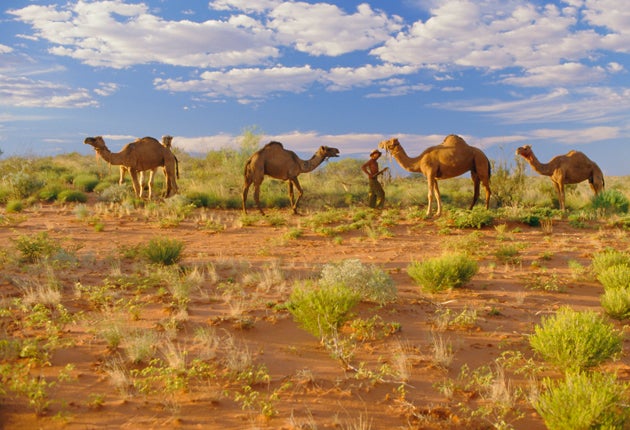Australia gets the hump – and reaches for the gun to settle its camel question
Brought to the country as beasts of burden in 1840, today there are one million camels eating the outback

There are more than a million of them and they pose one of the greatest social and environmental challenges to Australia's outback.
They munch their way through desert vegetation, further denuding this arid nation's heartland and threatening its sensitive ecosystem. They damage Aboriginal communities in their search for water, fracturing pipes and knocking air conditioning units off walls. And their population is more than doubling every eight to nine years.
The camel – which was introduced to Australia in 1840 to help transport heavy goods to the remote interior of the country – has now become one of its greatest pests. Dealing with the alarming population growth of one-humped Camelus dromedarius has been vexing governments, conservation bodies and scientists for years.
Now the federal government is to set aside nearly £10m to address the problem, which will almost certainly be solved at the barrel of a gun.
One option being considered is a mass aerial shoot – which experts regard as the most effective and humane method of culling the animals.
But killing camels is not quick or cheap, with costs of a cull estimated at around £50 an animal. And even if a cull removed 80,000 camels a year, it would do no more than match their birth rate.
The Desert Knowledge Cooperative Research Centre at Alice Springs, in the centre of the country, is masterminding how the federal funding will be spent. Its research general manager, Professor Murray McGregor, says previous efforts to deal with camel numbers have been hindered by the enormous scale of the problem.
In the outback, the animals leave a trail of destruction which costs property owners and Aboriginal communities nearly £7m a year, and much more in unmeasured social and environmental costs. "They'll eat anything up to 80 per cent of the plants available," Mr McGregor told The Sydney Morning Herald. This deprives indigenous desert animals of a food source, and indigenous people of a source of plants for traditional medicine and bush food.
Federal Environment Minister Peter Garrett describes the government's latest move as "the most significant commitment to tackle feral camels since they were introduced".
The landmark initiative will be spread over four years, with the money divided between Queensland, South Australia, Western Australia and the Northern Territory, where the camel population occupies a massive 3.3 million square kilometres of land.
But the federal government's strategy may not be the only answer.
On the sidelines of the great dromedary debate are those with commercial interests – the shooters and butchers who are also keen to get their hands on Australia's expanding camel population.
Some claim the market could be worth as much as £500m a year, but its success would depend on Aboriginal authorities allowing access to their sacred lands. With the use of mobile abattoirs, the processing of camel meat could create hundreds of jobs for indigenous people in areas where there is little or no work.
But while live camel exports have been successful on a small scale in the past, the industry has enjoyed only modest success in selling camel meat to domestic and overseas markets.
Pet food companies and leather makers have been good customers. However camel meat has never been a hit as a source of food for people – though it is not for lack of trying. Senior public servants in Canberra were served camel burgers at a barbecue last year, as part of a campaign to promote camel meat to consumers.
While Australians have developed a taste for kangaroo, emu and crocodile meat, camel has never made it onto the menu. Yet for the health conscious, it meets all the right criteria – lean, low in fat and with little cholesterol.
Specialist restaurants describe it as gamey in flavour, and a little tougher than beef. Despite the best efforts of the bushtucker industry, camel meat is rarely found on supermarket shelves or the nation's dinner plates. As a foodstuff, the ship of the desert has been cast adrift.
Counting the cost of camels
Camels were first imported to Australia in 1840 from the Canary Islands, and over the next half-century some 12,000 followed.
Most of them came from India and Palestine and were used as pack and riding animals by early outback pioneers. Under the care of Afghans, Camelus dromedarius made a major contribution to the early development of Australia's dry interior.
They helped with the construction of roads and railways and the Afghans, who were nicknamed "pilots of the desert", acted as guides for several major expeditions.
Twenty- four camels were hired for the ill-fated Burke and Wills expedition across the country's arid interior in l861.
While camels were still being worked as recently as the 1950s, they were largely replaced by trains and motor vehicles by the 1920s.
Redundant and allowed to run wild, they thrived and multiplied in their desert habitat and half a century later, Australia is counting the cost.
Join our commenting forum
Join thought-provoking conversations, follow other Independent readers and see their replies
Comments